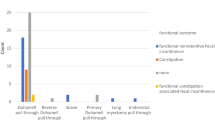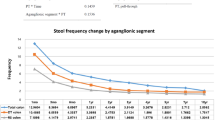Abstract
Although various surgical procedures have been described to treat Hirschsprung’s disease (HD), few studies have evaluated the long-term results of these children. The purpose of this study was to assess the long-term clinical outcome and bowel function of patients with HD. The hospital records of 259 consecutive patients with a confirmed histological diagnosis of HD during 1975–2003 were examined. Data was assessed for age at presentation, sex, clinical presentation, associated anomalies, level of aganglionosis, surgical procedures, complications and bowel function. Follow up was carried out by personal/telephone interviews with patients or their parents. Of the 259 patients with HD, 200 were males (77.2%) and 59 females (22.8%). Intestinal obstruction was the presenting feature in 147 patients (56.8%), intestinal perforation in 5 (1.9%), enterocolitis in 30 (11.6%) and constipation in 77 (29.7%). Thirty-nine patients (15.1%) had associated Down’s syndrome. Two hundred and nine patients (80.7%) had rectosigmoid disease, 31 (12%) had long segment disease and 19 (7.3%) had total colonic aganglionosis. Forty-three patients (16.6%) had preoperative enterocolitis. Primary colostomy was performed in 160 patients and a primary pull through in 90. Seven patients had a sphincteromyectomy for ultrashort HD. Two patients died prior to treatment. Various pull through procedures were performed in these patients. Postoperative complications included: pelvic abcess in 2, rectal stricture in 10, perianal excoriation in 7, anastomotic leak in 8, intestinal obstruction in 3, wound dehiscence in 1, stomal prolapse/stenosis in 5, rectovesical fistula in 2 and enterocolitis in 56. Five patients underwent a redo pull through and 46 required a post pull through sphincterectomy. At the time of follow-up, 27 were lost to follow-up, 9 died, 18 had permanent stomas and 4 were too young to assess bowel function. Of the remaining 194 patients, bowel function was normal in 132 (68%). Twenty patients (10.3%) had soiling and 42 (21.7%) had constipation requiring laxatives or enemas. There was no difference in bowel function in relation to type of pull through operation. Only 34% of patients with Down’s syndrome had normal continence. The majority of patients with HD continue to have disturbances of bowel function for many years before attaining normal continence.
Similar content being viewed by others
References
Moore S, Albertyn R, Cywes S (1996) Clinical outcome and long-term quality of life after surgical correction of Hirschsprung’s disease. J Pediatr Surg 31:1496–1502
Rescorla F, Morrison A, Engles D et al (1992) Hirschsprung’s disease: evaluation of mortality and long-term outcome in 260 cases. Arch Surg 127(8):934–941
Heij HA, De Vries X, Bremer I et al (1995) Long-term anorectal function after Duhamel operation for Hirschsprung’s disease. J Pediatr Surg 30(3):430–432
Bai Y, Chen H, Hao J et al (2002) Long-term outcome and quality of life after the Swenson procedure for Hirschsprung’s disease. J Pediatr Surg 37(4):639–642
Yanchar NL, Soucy P (1999) Long-term outcome after Hirschsprung’s disease: patients’ perspectives. J Pediatr Surg 34(7):1152–1160
Teitelbaum DH, Qualman SJ, Caniano DA (1998) Hirschsprung’s disease: identification of risk factors for enterocolitis. Ann Surg 207:240–244
Surana R, Quinn FMJ, Puri P (1994) Evaluation of risk factors in the development of enterocolitis complicating Hirschsprung’s Disease. Pediatr Surg Int 9:234–236
Quinn FMJ, Surana R, Puri P (1994) Influence of trisomy 21 on the outcome in children with Hirschsprung’s disease. J Pediatr Surg 29:781–783
Menezes M, Puri P (2005) Long-term clinical outcome in patients with Hirschsprung’s disease and associated Down’s syndrome. J Pediatr Surg 40:810–812
Teitelbaum DH, Drongowski RA, Chamberlain JN, Coran AG (1997) Long-term stooling patterns in infants undergoing primary endorectal pullthrough for Hirschsprung’s disease. J Pediatr Surg 32(7):1049–1052
Wildhaber B, Pakarinen M, Rintala R et al (2004) Posterior myotomy/myectomy for persistent stooling problems in Hirschsprung’s disease. J Pediatr Surg 39(6):920–926
Catto-Smith AG, Coffey CMM, Nolan TM, Hutson JM (1995) Fecal incontinence after the surgical treatment of Hirschsprung’s disease. J Pediatr 127(12):954–957
Caniano D, Teitelbaum D, Qualman S (1990) Management of Hirschsprung’s disease in children with trisomy 21. Am J Surg 159(4):402–404
Marty TL, Seo T, Matlak ME, Sullivan JJ, Black RE, Johnson DG (1995) Gastrointestinal function after surgical correction of Hirschsprung’s disease: long-term follow-up in 135 patients. J Pediatr Surg 30(5):655–658
Saleh W, Rasheed K, Al Mohaidly M et al (2004) Management of Hirschsprung’s disease: a comparison of Soave’s and Duhamel’s pull-through methods. Pediatr Surg Int 20:590–593
Quinn FMJ, Fitzgerald RJ, Guiney EJ et al (1992) Hirschsprung’s disease: a follow-up of three surgical techniques, 1979–1988. In: Hadziselimovic F, Herzog B (eds) Paediatric gastroenterology: inflammatory bowel disease and morbus Hirschsprung. Kluwer, Dordrecht, pp 297–301
Puri P, Nixon HH (1977) Long-term results of Swenson’s operation for Hirschsprung’s disease. Prog Pediatr Surg 10:87–96
Antao B, Radhwan T, Samuel M, Kiely E (2005) Short-pouch and low-anastomosis Duhamel procedure results in better fecal control and normal defecation pattern. Dis Colon Rectum 48(9):1791–1796
Wang NL, Lee HC, Yeh ML et al (2004) Experience with primary laparoscopy-assisted endorectal pull-through for Hirschsprung’s disease. Pediatr Surg Int 20(2):118–122
Endo M, Watanabe K, Fuchimoto Y et al (1994) Long-term results of surgical treatment in infants with total colonic aganglionosis. J Pediatr Surg 29(10):1310–1314
Wildhaber B, Coran AG, Teitelbaum DH (2005) Total colonic Hirschsprung’s disease: a 28 year experience. J Pediatr Surg 40(1):203–206
Tsuji H, Spitz L, Kiely EM et al (1999) Management and long-term follow-up of infants with total colonic aganglionosis. J Pediatr Surg 34(1):158–162
Author information
Authors and Affiliations
Corresponding author
Rights and permissions
About this article
Cite this article
Menezes, M., Corbally, M. & Puri, P. Long-term results of bowel function after treatment for Hirschsprung’s disease: a 29-year review. Pediatr Surg Int 22, 987–990 (2006). https://doi.org/10.1007/s00383-006-1783-8
Published:
Issue Date:
DOI: https://doi.org/10.1007/s00383-006-1783-8




